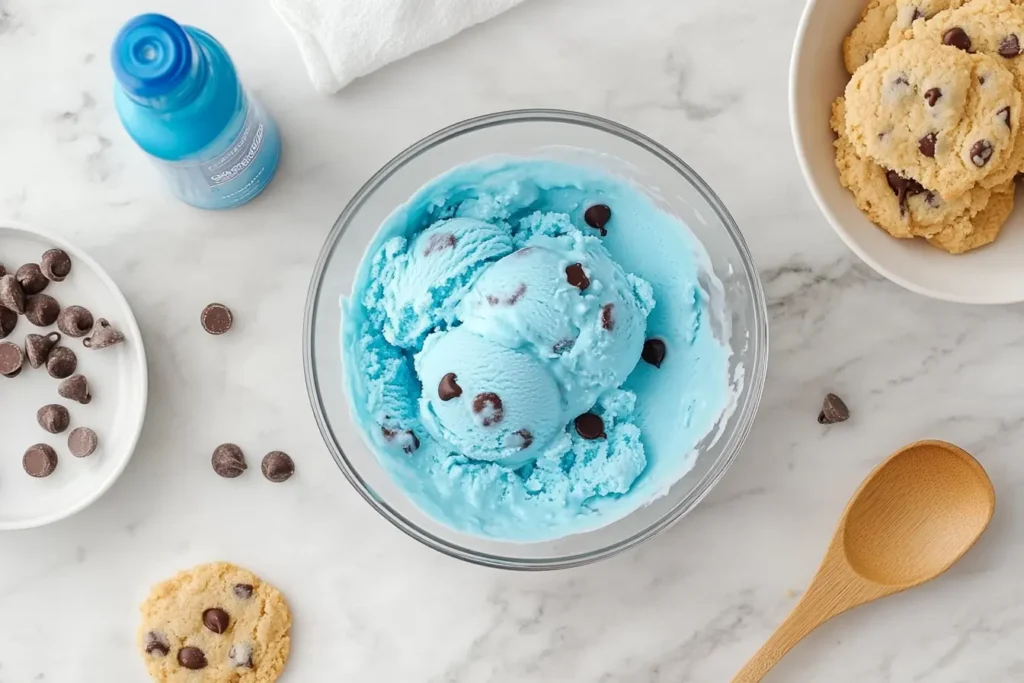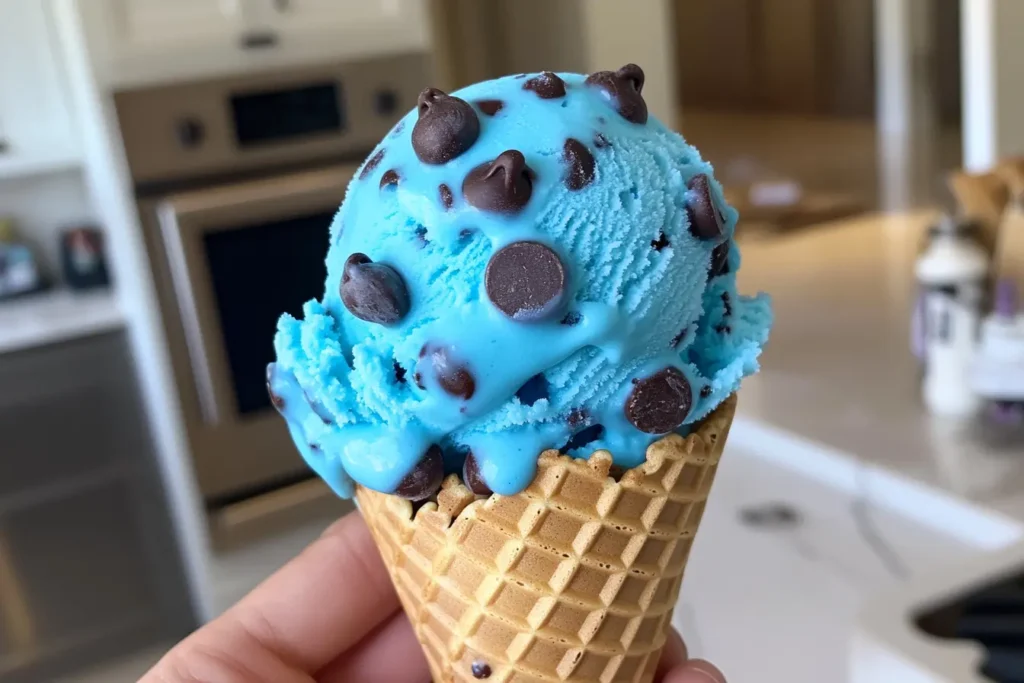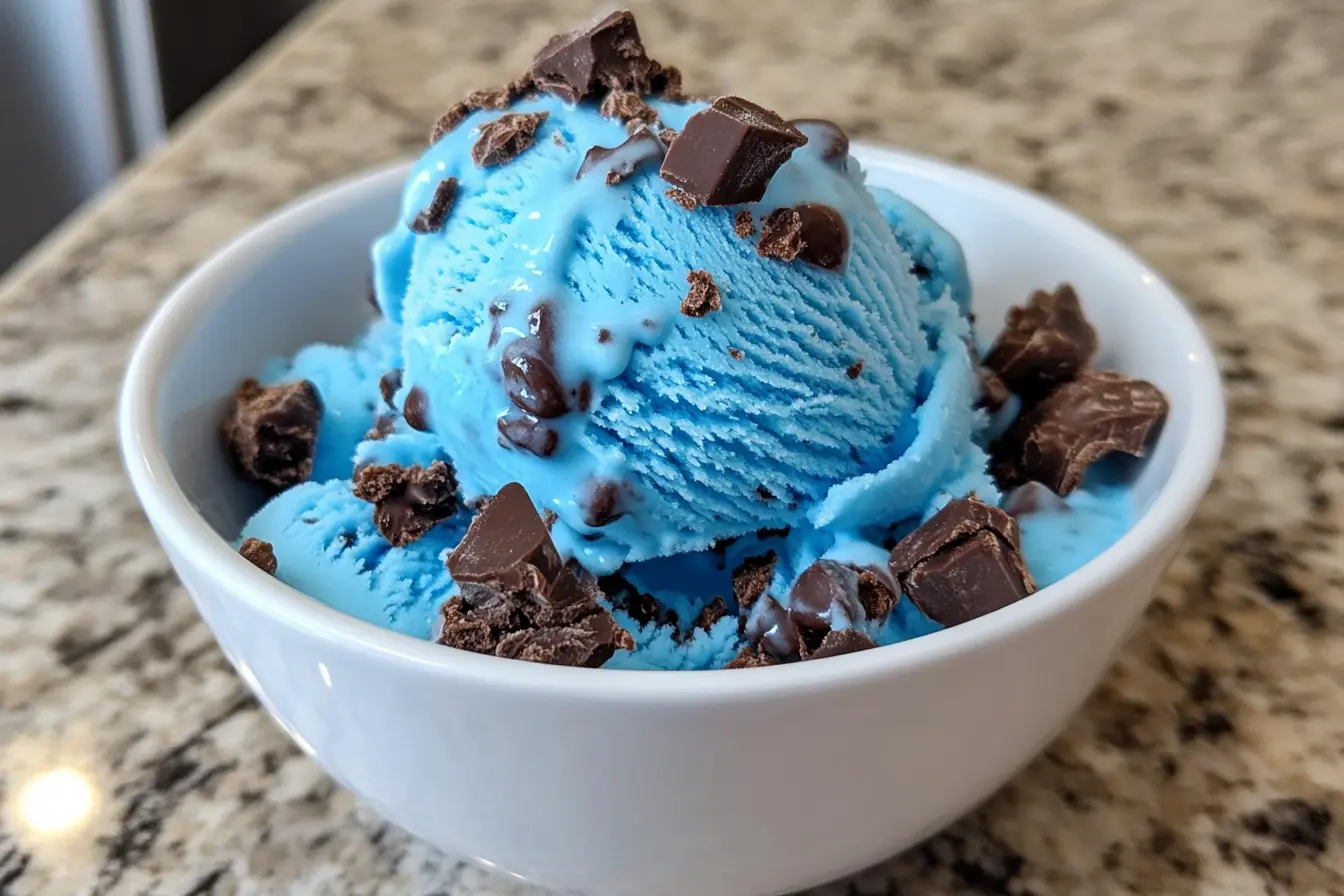Introduction
Cookie Monster ice cream is one of those treats that instantly grabs attention. With its vibrant blue color and chunks of cookies, it’s no wonder kids and adults alike can’t resist it. The combination of creamy vanilla ice cream, chocolate chip cookies, and Oreos creates a nostalgic, indulgent experience that feels as fun as it looks. But have you ever wondered, why is Cookie Monster ice cream blue? Is it just food coloring, or is there more to it?
Some might assume the blue hue is purely for aesthetic appeal, but the story goes beyond just adding dye. The color plays a psychological role in making the dessert more visually exciting, while some variations use natural ingredients to achieve the effect.
In this article, we’ll dive into the science behind the blue hue, the ingredients used, and even natural alternatives to artificial dyes. Plus, we’ll explore whether blue food coloring is safe, how you can make this ice cream at home, and answer some burning questions people often ask. Let’s get started!
What Is Cookie Monster Ice Cream?
The Origins of Cookie Monster Ice Cream
Cookie Monster ice cream didn’t just appear out of nowhere. This playful, eye-catching dessert was inspired by none other than Cookie Monster, the beloved Sesame Street character known for his insatiable love of cookies. With his wild, googly eyes and uncontrollable excitement for anything cookie-related, it only made sense to create an ice cream that embodied his fun-loving personality.
The concept? Make a dessert as fun to look at as it is to eat! That’s why Cookie Monster ice cream is not just any ordinary ice cream—it’s a vibrant blue masterpiece loaded with chunks of cookies to match Cookie Monster’s signature obsession. But the big question remains: who actually invented it?
Who Created Cookie Monster Ice Cream?
Unlike some classic ice cream flavors with clear origins, no single company can claim credit for inventing Cookie Monster ice cream. Instead, it seems to have evolved organically as ice cream shops experimented with new and exciting flavors.
Over time, various ice cream parlors and dessert brands put their own unique spin on the concept. Some went with a classic vanilla base, while others introduced flavors like:
- Cookies and cream, blending in crushed Oreos for extra crunch
- Chocolate chip cookie dough, adding chunks of raw cookie dough for a chewy texture
- Cotton candy or cake batter flavors, enhancing the sweetness and fun factor
Today, you’ll find Cookie Monster ice cream in ice cream parlors, specialty dessert shops, and even some grocery stores, each with its own twist on the original idea. The only constants? It’s always blue, always packed with cookies, and always a nostalgic treat!
Key Ingredients in Cookie Monster Ice Cream
Cookie Monster ice cream isn’t just about the blue color. It’s also about the perfect mix of ingredients that make it deliciously fun.
- Base Flavor: Most recipes use a vanilla ice cream base, but some brands experiment with cookies and cream or even chocolate chip cookie dough.
- Cookies: It wouldn’t be Cookie Monster ice cream without cookies! Popular choices include chocolate chip cookies, Oreos, and even cookie dough pieces.
- Blue Food Coloring: This is what gives it that signature Cookie Monster look. But what exactly makes it so blue? That’s what we’ll explore in the next section.
The Science Behind the Blue Color
What Makes Cookie Monster Ice Cream Blue?
So, why is Cookie Monster ice cream blue? The answer lies in food coloring. Most commercial versions use FD&C Blue No. 1, also known as Brilliant Blue FCF, a synthetic dye approved by the FDA for food use. This dye is water-soluble, meaning it blends seamlessly into the ice cream mix, creating that bold, eye-catching blue hue.
But here’s the thing—blue isn’t a common color in food! Our brains associate blue with toxins or spoiled food, which is why blue foods stand out so much. However, in the case of Cookie Monster ice cream, the playful association with the Sesame Street character makes it fun and appetizing rather than off-putting.
Does Blue Food Coloring Affect Taste?
Nope! FD&C Blue No. 1 is completely tasteless. The ice cream still tastes like vanilla, cookies and cream, or cookie dough, depending on the recipe. That means the color is purely for visual appeal—it has nothing to do with flavor.
However, some people claim they perceive a slight difference when eating foods with bright colors. This is because our brains sometimes trick us into associating color with taste. But scientifically speaking, blue food dye does not alter the flavor profile of Cookie Monster ice cream.
Natural Alternatives to Blue Food Coloring
Not a fan of artificial dyes? No worries! There are several natural ways to achieve that striking blue color without using synthetic food coloring. Here are some top options:
- Butterfly Pea Flower: This natural plant-based ingredient creates a deep blue color when steeped in liquid. It’s commonly used in teas and can be a great natural food dye for ice cream.
- Spirulina Powder: Derived from blue-green algae, spirulina is a superfood that provides a natural blue-green tint. It’s packed with antioxidants and is completely safe to eat.
- Blueberries & Purple Sweet Potatoes: While these don’t create the exact same neon blue color, they do provide a rich, natural bluish-purple hue that works well in homemade recipes.

Is Blue Food Coloring Safe?
FDA Regulations on Food Coloring
Many people wonder whether artificial food dyes, like FD&C Blue No. 1, are safe for consumption. The good news? The FDA has approved Blue No. 1 as a food additive, meaning it has undergone rigorous testing to ensure it’s non-toxic and safe.
The FDA reviews scientific studies, toxicology reports, and long-term health effects before approving any food dye. So far, research suggests that Blue No. 1 is safe in normal dietary amounts.
Additionally, the European Food Safety Authority (EFSA) and other global health organizations have also approved it. But, like anything else, moderation is key!
Health Effects of Artificial Food Coloring
Although FD&C Blue No. 1 is widely approved for consumption, some people remain skeptical about the long-term effects of artificial food dyes. Over the years, studies have explored their potential impact on health, leading to concerns about issues like hyperactivity, allergic reactions, and digestive discomfort. While these effects are rare and often debated, it’s important to understand what science says about artificial food coloring and how it might affect different individuals.
Hyperactivity in Children: A Real Concern or Just a Myth?
One of the biggest concerns surrounding artificial food dyes is their potential link to hyperactivity in children. Some studies, particularly the famous Southampton Study (2007), suggested that consuming certain artificial food dyes, including Blue No. 1, may increase hyperactivity and attention issues in children with ADHD or heightened sensitivity to synthetic additives.
However, the FDA and European Food Safety Authority (EFSA) reviewed these studies and concluded that the evidence remains largely inconclusive. While some children may experience mild behavioral changes, the majority of kids can consume these dyes regularly without any noticeable effects. That said, the UK has taken a precautionary approach, requiring warning labels on some artificial dyes, while the U.S. FDA continues to allow their use freely without restrictions or limitations.
Allergic Reactions: Can Artificial Dyes Trigger Sensitivities?
Although allergic reactions to food dyes are rare, they can occur in sensitive individuals. Some people may experience symptoms such as:
- Skin rashes or hives
- Mild digestive discomfort
- Headaches or dizziness (in extreme cases)
For most people, these reactions are not serious. However, those with dye sensitivities or existing food allergies should be cautious when consuming brightly colored foods, especially those containing multiple synthetic dyes.
The Blue Tongue Effect: Harmless but Annoying
Ever noticed your tongue turning bright blue after eating Cookie Monster ice cream? That’s due to the high concentration of Blue No. 1 in the dessert. Since food dyes are designed to bind to water-based substances, they temporarily stain the tongue, teeth, and even lips. But don’t worry—this effect is harmless and fades within a few hours. If you’re heading to an important event, though, you might want to wait before indulging in a bright blue scoop!
Should You Be Concerned?
For the vast majority of people, eating Cookie Monster ice cream occasionally is perfectly safe. Regulatory agencies like the FDA, EFSA, and WHO have deemed Blue No. 1 safe for human consumption at normal dietary levels. However, if you have concerns about artificial dyes, here are a few steps you can take:
✅ Limit your intake of artificially colored foods, especially if you notice sensitivity or behavioral changes.
✅ Opt for natural alternatives, like butterfly pea flower extract or spirulina, which provide a vibrant blue color without synthetic additives.
✅ Check ingredient labels if you prefer to avoid artificial dyes altogether. Many brands now offer dye-free or naturally colored alternatives.
At the end of the day, moderation is key. If you love Cookie Monster ice cream but want a healthier option, try making it at home using natural food colorings—you’ll still get that fun blue hue without any artificial additives!
How to Make Cookie Monster Ice Cream at Home
Homemade Recipe for Cookie Monster Ice Cream
If you love Cookie Monster ice cream but want to skip the store-bought versions, good news—you can make it at home with just a few simple ingredients! The best part? You can control the flavor, texture, and type of food coloring used.
Ingredients:
- 2 cups heavy cream
- 1 cup whole milk
- ¾ cup sweetened condensed milk
- 1 tablespoon vanilla extract
- ½ teaspoon salt
- ½ cup crushed chocolate chip cookies
- ½ cup crushed Oreos
- 3-5 drops blue food coloring (or a natural alternative like butterfly pea flower extract)
Step-by-Step Instructions:
- Whisk together the heavy cream, whole milk, sweetened condensed milk, vanilla extract, and salt in a mixing bowl.
- Add blue food coloring (or natural dye) and mix until the color is evenly distributed.
- Pour the mixture into an ice cream maker and churn according to the manufacturer’s instructions.
- When the ice cream is almost set, fold in the crushed cookies to get that signature Cookie Monster texture.
- Transfer to a container, cover, and freeze for at least 4 hours before serving.
This recipe creates a creamy, rich, and ultra-blue ice cream with the perfect mix of cookies and cream flavor!
Customizing Your Cookie Monster Ice Cream
One of the best things about making your own Cookie Monster ice cream is that you can customize it to your liking. Here are a few fun variations:
- Switch up the cookies! Instead of Oreos, try crushed peanut butter cookies or chocolate wafer cookies.
- Make it dairy-free! Use coconut milk and dairy-free chocolate chip cookies for a vegan-friendly version.
- Add mix-ins! Want more texture? Toss in some mini chocolate chips or swirls of caramel.

Can You Make Cookie Monster Ice Cream Without an Ice Cream Maker?
Absolutely! If you don’t have an ice cream machine, simply:
- Whip the heavy cream until soft peaks form.
- Fold in the condensed milk, vanilla, and food coloring.
- Gently stir in the cookies, transfer to a container, and freeze for 6 hours.
This no-churn method makes an equally delicious and creamy version with minimal effort.
Frequently Asked Questions
Many people have questions about why Cookie Monster ice cream is blue, what it tastes like, and whether it’s safe to eat. Below, we’ve answered some of the most common FAQs about this fun and colorful dessert!
What Flavor Is Cookie Monster Ice Cream?
Despite its bright blue color, Cookie Monster ice cream is not blueberry-flavored! Instead, most versions are vanilla-based, with chunks of chocolate chip cookies and Oreos mixed in. Some variations use cookie dough or cookies and cream ice cream as the base.
Does the Blue Food Coloring Change the Taste?
Nope! Blue food coloring is tasteless, so it doesn’t affect the flavor of the ice cream at all. The flavor comes from the ice cream base and the mix-ins, not the color.
Can I Make Cookie Monster Ice Cream Without Artificial Coloring?
Absolutely! If you want to avoid synthetic dyes, you can use natural alternatives like:
- Butterfly pea flower extract (creates a deep blue color)
- Spirulina powder (a plant-based blue-green algae)
- Blueberries or purple sweet potatoes (for a more subtle blue-purple hue)
Is Cookie Monster Ice Cream Safe for Kids?
Yes! Cookie Monster ice cream is perfectly safe for children in normal amounts. However, if you’re concerned about artificial dyes, you can always opt for natural color alternatives.
Does Blue Ice Cream Stain Your Tongue?
Yes! Blue food dye is notorious for staining tongues, lips, and even fingers. But don’t worry—it’s temporary and washes away after a few hours. If you prefer a non-staining version, try butterfly pea flower extract instead.
Where Can I Buy Cookie Monster Ice Cream?
Cookie Monster ice cream is available at:
- Specialty ice cream shops
- Gourmet dessert stores
- Some grocery stores (depending on location)
- Online recipes (for homemade versions)
If you’re looking for a fun and colorful ice cream experience, this treat is definitely worth trying!
Conclusion
Cookie Monster ice cream isn’t just a dessert—it’s an experience! From its bold blue color to its creamy texture and cookie-packed goodness, every bite is a playful celebration of flavor. It’s a treat that brings nostalgia, excitement, and curiosity, making it a fan favorite for both kids and adults. But as we’ve explored, there’s a lot more to this ice cream than just its fun appearance.
At first glance, it might seem like the only reason Cookie Monster ice cream is blue is because of FD&C Blue No. 1, the artificial food dye responsible for its iconic hue. While this synthetic dye is FDA-approved and widely used, some people prefer to steer clear of artificial colors due to potential sensitivities or personal health choices. Luckily, natural alternatives like butterfly pea flower and spirulina offer a way to achieve that striking blue color without synthetic additives. These plant-based options not only provide vibrant hues but also come with added health benefits, making them a great alternative for those looking for a more natural approach.
If you’ve ever wanted to make Cookie Monster ice cream at home, you’re in luck—it’s easier than you might think! Whether you have an ice cream maker or prefer a no-churn method, this playful dessert is fully customizable. You can experiment with different cookie mix-ins, swap out the base flavors, or even create a dairy-free version using plant-based ingredients. The best part? You control what goes into it, so you can tweak the recipe to fit your taste preferences and dietary needs.
So, the next time you spot a vibrant blue scoop of Cookie Monster ice cream, you’ll know exactly why it’s blue, what’s inside, and how you can make it yourself. No matter how you enjoy it—whether at an ice cream shop, from the freezer aisle, or straight from your own kitchen—one thing is certain: this ice cream is just as fun to eat as it is to look at! 🍦💙

